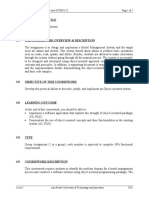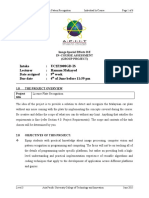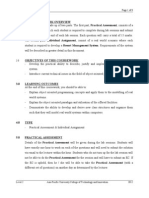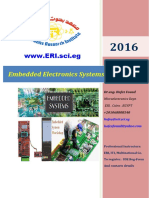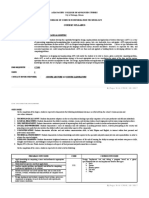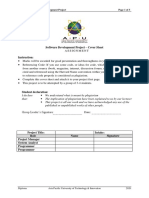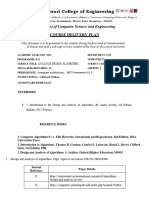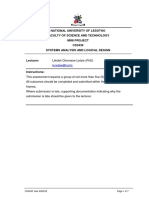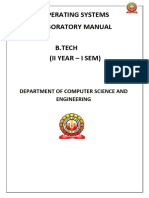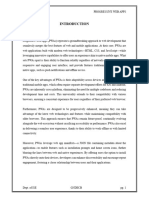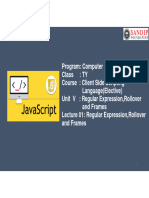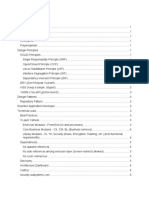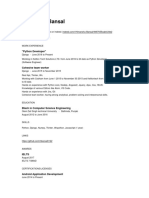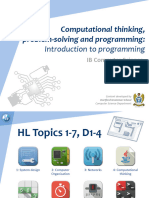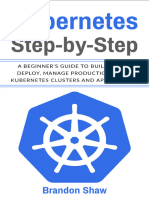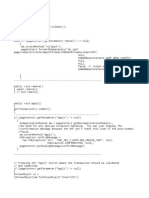Java Automotive
Java Automotive
Uploaded by
Zahirul WayneCopyright:
Available Formats
Java Automotive
Java Automotive
Uploaded by
Zahirul WayneOriginal Description:
Original Title
Copyright
Available Formats
Share this document
Did you find this document useful?
Is this content inappropriate?
Copyright:
Available Formats
Java Automotive
Java Automotive
Uploaded by
Zahirul WayneCopyright:
Available Formats
Object Oriented Development with Java (CT038-3-2) Page 1 of 6
Learning Outcomes:
On conclusion students should be able to:
CLO1: Explain the techniques of Object Oriented Design(C2,PLO1)
CLO2: Implement a software application that exploits the strength of object-oriented
paradigm(C6,PL02)
CLO3: Demonstrate the use of object oriented concepts and their functionalities in the existing
system(A3,PL04)
Programme Outcomes (PO):
PLO1: Describe the essential facts, concepts, principles and processes involved in the effective
deployment of software solutions to solve practical problems related to Software
Engineering and computer applications
PLO2: Demonstrate logical and analytical thinking skills to develop innovative software solutions
for various applications
PLO4: Be a responsible software developer and practitioner within a social environment, with
capabilities to work in teams
No. Learning Outcome Assessment
1 Explain the techniques of Object Oriented Design (C2, PLO1) Class Test
2 Implement a software application that exploits the strength Group Assignment
of object-oriented paradigm(C6,PL02)
3 Demonstrate the use of object oriented concepts and their Group Assignment
functionalities in the existing system(A3,PL04)
Assignment Cognitive Level Psychomotor Level Affective Level
Question
1 2 3 4 5 6 1 2 3 4 5 6 7 1 2 3 4 5
80M 20M
OOMS 80% 20%
Level 2 Asia Pacific University of Technology and Innovation 2019
Object Oriented Development with Java (CT038-3-2) Page 2 of 6
1.0 COURSEWORK TITLE
APU AUTOMOTIVE SERVICE CENTRE
2.0 THE COURSEWORK OVERVIEW
The assignment is to design and implement an APU Automotive Service Centre (AASC). This
expected system is for the centre managers to handle end user registration and help centre
customers to register & book for car servicing appointments. Besides, the system is also for the
centre technicians to check their individual appointments and to collect payment & provide
feedback at the end of each appointment. In addition, the system is necessarily to be designed
and developed using object-oriented approach covering object orientation concepts and
principles. Furthermore, a supporting document is required to reflect the design and the
implementation details demonstrating the object-oriented programming concepts and their code
samples.
3.0 OBJECTIVES OF THIS COURSEWORK
Develop the practical ability to describe, justify, and implement an object-oriented system.
4.0 LEARNING OUTCOMES
At the end of this coursework, you should be able to:
Design and develop a software solution using object-oriented paradigm and translate it
into software application that exploit the strength of object-oriented paradigm (C6, PLO2)
Demonstrate object-oriented concepts and their functionalities in the existing system (A3,
PLO4)
5.0 TYPE
Group Assignment (2 in a group)
Level 2 Asia Pacific University of Technology and Innovation 2019
Object Oriented Development with Java (CT038-3-2) Page 3 of 6
6.0 COURSEWORK DESCRIPTION
This coursework requires students to identify a business domain for an automotive service centre.
Construct a software solution using object-oriented programming paradigm to support user
registration, appointment booking, payment collection, and feedback after appointment. The
target users of the system are centre managers and technicians. The developed system should
achieve the following requirements but not limited to:
System login records for authentication and authorisation process.
Manage end-user information and their roles for access control
Manage customer registration and appointment booking
Manage payment collection and feedback after each servicing appointment
With the aforementioned requirements, you are expected to analyse a business domain pertaining
to an automotive service centre. All the information must be saved in text file. Apart from these,
the general settings and data configuration as well as fundamental functions are included to
facilitate the end users.
You are also required to identify the relationship among the entities and also develop the
necessary methods needed to fulfil the requirements of the expected systems.
7.0 GENERAL REQUIREMENTS
The program submitted should compile and be executed without errors
Validation should be done for each entry from the users in order to avoid logical errors.
The implementation code must highlight the use of object-oriented programming concepts
as required by the solution.
Students should use text files for storing and retrieving data required for the system.
Not allowed to use any database tools like access / oracle etc.
8.0 DELIVERABLES:
- The system with complete code submitted in the form of a CD-ROM.
- Documents delivered in printed and softcopy form.
- Submission deadline: Monday, 17th February 2020, 5:00 pm
Level 2 Asia Pacific University of Technology and Innovation 2019
Object Oriented Development with Java (CT038-3-2) Page 4 of 6
8.1 SYSTEM & DOCUMENATION IN CD FORMAT
The completed application of the system as well as the softcopy of the report must be
burned onto a CD-ROM.
The application must contain all the relevant source code.
8.2 DOCUMENTS: COURSEWORK REPORT
As part of the assessment, you must submit the project report in printed and softcopy
form, which should have the following format:
A) Cover Page:
All reports must be prepared with a front cover. A protective transparent plastic
sheet can be placed in front of the report to protect the front cover. The front cover
should be presented with the following details:
Module
Coursework Title
Intake
Group member (Student name and ID)
Date Assigned (the date the report was handed out).
Date Completed (the date the report is due to be handed in).
B) Contents:
Description and justification of the design and the implementation codes
which illustrate the object oriented programming concepts incorporated into
the solution
A 2000-word report based on the object-oriented topic researched
C) Conclusion
D) References
The font size used in the report must be 12pt and the font is Times New
Roman. Full source code is not allowed to be included in the report. The
report must be typed and clearly printed.
You may source algorithms and information from the Internet or books.
Proper referencing of the resources should be evident in the document.
All references must be made using the Harvard Naming Convention as shown
below:
The theory was first propounded in 1970 (Larsen, A.E. 1971), but since then
has been refuted; M.K. Larsen (1983) is among those most energetic in their
opposition……….
/**
Level 2 Asia Pacific University of Technology and Innovation 2019
Object Oriented Development with Java (CT038-3-2) Page 5 of 6
* Following source code obtained from (Danang, S.N. 2002)
*/
int noshape=2;
noshape=GetShape();
List of references at the end of your document or source code must be
specified in the following format:
Larsen, A.E. 1971, A Guide to the Aquatic Science Literature, McGraw-Hill,
London.
Larsen, M.K. 1983, British Medical Journal [Online], Available from
http://libinfor.ume.maine.edu/acquatic.htm (Accessed 19 November 1995)
Danang, S.N., 2002, Finding Similar Images [Online], The Code Project,
*Available from http://www.codeproject.com/bitmap/cbir.asp, [Accessed
14th *September 2006]
Further information on other types of citation is available in Petrie, A., 2003,
UWE Library Services Study Skills: How to reference [online], England,
University of Western England, Available from
http://www.uweac.uk/library/resources/general/info_study_skills/harvard2.
htm, [Accessed 4th September 2003].
Level 2 Asia Pacific University of Technology and Innovation 2019
Object Oriented Development with Java (CT038-3-2) Page 6 of 6
9.0 ASSIGNMENT ASSESSMENT CRITERIA
The assignment assessment consists of four components: Requirement Analysis (20%),
Implementation (40%), Report (30%), and Presentation (10%). Details of the allocation for
each component are as follows:
Criteria Marks allocated
Requirement Analysis: [CLO2-PLO2] 20%
- Use-case diagram 10%
- Class diagram 10%
Implementation: [CLO2-PLO2] 40%
User Access (Shared implementation by group members) 10%
Managers (Group Member A) 30%
Or
Technicians (Group Member B) 30%
Report: [CLO2-PLO2] 30%
- Report Format and References 10%
- Program Documentation 20%
Presentation: [CLO3-PLO5]
10%
Ability to answer questions addressed by the lecturer pertaining to
the work done and presented
10.0 DEVELOPMENT TOOLS
The program must be written in Java and you can use any Java development IDE as a tool
but the back-end must be .txt files.
11.0 ACADEMIC INTEGRITY
- You are expected to maintain the utmost level of academic integrity during the duration
of the module.
- Plagiarism is a serious offence and will be dealt with according to APU regulations on
plagiarism.
Level 2 Asia Pacific University of Technology and Innovation 2019
You might also like
- AutoCAD Electrical 2023 for Electrical Control Designers, 14th EditionFrom EverandAutoCAD Electrical 2023 for Electrical Control Designers, 14th EditionNo ratings yet
- The Ultimate Guide To DynamoDocument10 pagesThe Ultimate Guide To DynamoAwes SewsaNo ratings yet
- AutoCAD CertificateDocument1 pageAutoCAD CertificateFrederick Jose Forca RañinNo ratings yet
- 2209 OODJ AsstQuestionDocument5 pages2209 OODJ AsstQuestionVishva LenqchaiiNo ratings yet
- APT3F1706CYB CE00336 6 IPCV Incourse AssignmentDocument9 pagesAPT3F1706CYB CE00336 6 IPCV Incourse Assignmentcaleb tee0% (1)
- 18csl66 - Ss Lab ManualDocument116 pages18csl66 - Ss Lab ManualSPOORTHI S50% (2)
- AP SummativeAssesment OL2Document8 pagesAP SummativeAssesment OL2kamranNo ratings yet
- AutoCAD Electrical 2017 for Electrical Control Designers, 8th EditionFrom EverandAutoCAD Electrical 2017 for Electrical Control Designers, 8th EditionRating: 3 out of 5 stars3/5 (1)
- PCPPAssignment UC2F1408Document6 pagesPCPPAssignment UC2F1408SreePrakashNo ratings yet
- Coursework Title: Object Oriented Development With Java (CT038-3-2) Page 1 of 5Document5 pagesCoursework Title: Object Oriented Development With Java (CT038-3-2) Page 1 of 5Apichaya NivasabutrNo ratings yet
- APU2F2106 APD2F2106 OODJ AsstQuestion Updated16jun21Document7 pagesAPU2F2106 APD2F2106 OODJ AsstQuestion Updated16jun21ccnimingNo ratings yet
- 3 - Assignment Question - UpdatedDocument5 pages3 - Assignment Question - Updatedjames smithNo ratings yet
- UC2F1205 PCPP AssignmentDocument8 pagesUC2F1205 PCPP AssignmentAbubaker Baffik KigenyiNo ratings yet
- 18csl66-Ss and Os Lab ManualDocument55 pages18csl66-Ss and Os Lab ManualAkansha SinghNo ratings yet
- IOOP - Assignment QuestionDocument10 pagesIOOP - Assignment QuestionParvinder McCartneyNo ratings yet
- ISE Individual ProjectDocument6 pagesISE Individual ProjectCk VinNo ratings yet
- Assignment OODJDocument6 pagesAssignment OODJKushanedra ShanmugalingamNo ratings yet
- 2008 ISE Group AssignmentDocument6 pages2008 ISE Group AssignmentJaneNo ratings yet
- 2209 OODJ AsstQuestionDocument5 pages2209 OODJ AsstQuestionnikitha upadhyaNo ratings yet
- 1.0 Coursework Title: Object Oriented Development With Java (CT038-3-2) Page 1 of 4Document4 pages1.0 Coursework Title: Object Oriented Development With Java (CT038-3-2) Page 1 of 4Elissa Jane NesanNo ratings yet
- 6716-1709028948603-CS6003ES - MS - Coursework 2Document5 pages6716-1709028948603-CS6003ES - MS - Coursework 2Theekshana Peiris100% (1)
- OODJ A+ AssignmentDocument7 pagesOODJ A+ AssignmentElaine LaLaNo ratings yet
- Dissertation Guidelines - BCA 6th SEMDocument14 pagesDissertation Guidelines - BCA 6th SEMNavin Kumar ji simariNo ratings yet
- APU2F2102-OODJ-AssignmtQuestionDocument6 pagesAPU2F2102-OODJ-AssignmtQuestionNasser AlmakhzoomNo ratings yet
- Minor Project (MCA-169) - MCA2022-24 - FormatDocument14 pagesMinor Project (MCA-169) - MCA2022-24 - FormatVandana GariaNo ratings yet
- 18CSL66 - SS Lab ManualDocument83 pages18CSL66 - SS Lab ManualSpoorthi.comSNo ratings yet
- Exam_Example_Distributed Systems and Cloud Computing_Summer_2024Document6 pagesExam_Example_Distributed Systems and Cloud Computing_Summer_2024hixel50400No ratings yet
- OS_LAB_MANUAL CSE-2024-25Document58 pagesOS_LAB_MANUAL CSE-2024-25nagashreeavadhani2011No ratings yet
- Screenshot 2023-08-08 at 9.45.58 PMDocument8 pagesScreenshot 2023-08-08 at 9.45.58 PMreembadran223No ratings yet
- CS6003ES - ASE - Coursework 2 2023Document5 pagesCS6003ES - ASE - Coursework 2 2023rasanjali2 789100% (1)
- Assignment QuestionDocument6 pagesAssignment QuestionSpam UseNo ratings yet
- PCPP Assignment QuestionDocument8 pagesPCPP Assignment QuestionHock HuatNo ratings yet
- MCA_Sysnopsis_GuidelinesDocument5 pagesMCA_Sysnopsis_GuidelinesShomil TiwariNo ratings yet
- DS Lab ManualDocument43 pagesDS Lab Manualgsmanjushree19No ratings yet
- DSA Lab Manual 2024-2025 UpdatedDocument86 pagesDSA Lab Manual 2024-2025 Updatedmanjunath.arjun1978No ratings yet
- Project 1Document2 pagesProject 1Anonymous XpakVbJYDSNo ratings yet
- Assignment UC2F1307Document7 pagesAssignment UC2F1307Kin SkyeNo ratings yet
- Individual Project Specifications (Fall 2020)Document3 pagesIndividual Project Specifications (Fall 2020)Eben LeonardNo ratings yet
- كتيب محتوى الدبلومةDocument7 pagesكتيب محتوى الدبلومةAhmed El-AdawyNo ratings yet
- Assignment BriefDocument7 pagesAssignment BriefSARA ALABAHRAANo ratings yet
- AAPP006 4 2 SDP - GuidelinesDocument9 pagesAAPP006 4 2 SDP - GuidelinesRoger GanNo ratings yet
- UoM Projectformat BSCITDocument27 pagesUoM Projectformat BSCITMathana SumanNo ratings yet
- CC104 SCDocument10 pagesCC104 SCNINA BautistaNo ratings yet
- Oop M16Document12 pagesOop M16Ashen WeerasingheNo ratings yet
- SE ReportDocument43 pagesSE ReportKen Adams100% (1)
- DS Lab Manual CSE_updatedDocument61 pagesDS Lab Manual CSE_updatednagashreeavadhani2011No ratings yet
- A Capstone Project in Software Development For Cis Majors: January 2006Document6 pagesA Capstone Project in Software Development For Cis Majors: January 2006Allen Ray Lopez SaclagNo ratings yet
- Design Doc SampleDocument4 pagesDesign Doc SamplesrikanthNo ratings yet
- 2018 Semester and Bachelor Project Report Template - VIA ICT Engineering GuidelinesDocument16 pages2018 Semester and Bachelor Project Report Template - VIA ICT Engineering GuidelinesLupu StefanNo ratings yet
- AAPP006-4-2-SDP Project Case StudyDocument3 pagesAAPP006-4-2-SDP Project Case StudyRoger GanNo ratings yet
- Ada Course PlanDocument9 pagesAda Course Planrichardwill11No ratings yet
- Assignment QuestionDocument6 pagesAssignment QuestionFarah ElisyaNo ratings yet
- Pdie - 16 - 001Document12 pagesPdie - 16 - 001Sudharaka SanjeewaNo ratings yet
- Project Guideline For BCA-6th SemDocument8 pagesProject Guideline For BCA-6th SemNitin PatelNo ratings yet
- CS3430 Project Instructions 2023Document7 pagesCS3430 Project Instructions 2023Bokang LerataNo ratings yet
- OODJ AssignmentDocument6 pagesOODJ AssignmentSagaaboyz Mg R0% (1)
- SD Lab Manual Kushagra Mehrotra A117Document62 pagesSD Lab Manual Kushagra Mehrotra A117Kushagra MehrotraNo ratings yet
- Operating Systems Lab - Cse - IdealDocument77 pagesOperating Systems Lab - Cse - IdealAmit Bikram MishraNo ratings yet
- Static Analysis of Software: The Abstract InterpretationFrom EverandStatic Analysis of Software: The Abstract InterpretationNo ratings yet
- InduSoft Application Design and SCADA Deployment Recommendations for Industrial Control System SecurityFrom EverandInduSoft Application Design and SCADA Deployment Recommendations for Industrial Control System SecurityNo ratings yet
- Software Application Development Tools & Techniques PDFDocument3 pagesSoftware Application Development Tools & Techniques PDFAkash DhepleNo ratings yet
- Sencha ExtJS Datasheet WebDocument2 pagesSencha ExtJS Datasheet WebefarfanNo ratings yet
- Seminar Report (ISp)Document21 pagesSeminar Report (ISp)hussaindaniyal306No ratings yet
- IMC411 Guidelines For Group ProjectDocument6 pagesIMC411 Guidelines For Group ProjectWAN MUHAMMAD MIFZAL WAN ZANAIDINo ratings yet
- Android Application DevelopmentDocument21 pagesAndroid Application Developmented tuNo ratings yet
- UNIT V Regular Expression, Rollover and FramesDocument31 pagesUNIT V Regular Expression, Rollover and FramesPrashant BhamareNo ratings yet
- Python Control Flow Cheatsheet KDnuggetsDocument1 pagePython Control Flow Cheatsheet KDnuggetsJohn McClaineNo ratings yet
- Approve Time SheetDocument2 pagesApprove Time Sheetkb2009No ratings yet
- Database Architecture Oracle DbaDocument41 pagesDatabase Architecture Oracle DbaImran ShaikhNo ratings yet
- OutSystems ReviewerDocument9 pagesOutSystems ReviewerAeron Joseph SantosNo ratings yet
- Himanshu Bansal: Cohesive Team WorkerDocument3 pagesHimanshu Bansal: Cohesive Team WorkerBalakrishna BalaNo ratings yet
- Al Rouman (Web Lab Report 2)Document7 pagesAl Rouman (Web Lab Report 2)Abrar RomanNo ratings yet
- Docker Swarm Cluster On AWS With AnsibleDocument31 pagesDocker Swarm Cluster On AWS With AnsibleedwinbuikeNo ratings yet
- Computational Thinking, Problem-Solving and ProgrammingDocument11 pagesComputational Thinking, Problem-Solving and ProgrammingemyokomoNo ratings yet
- نموذج ورقة ميزانية مشروع Project-budget-Template-1Document4 pagesنموذج ورقة ميزانية مشروع Project-budget-Template-1kingNo ratings yet
- Software RequirementsDocument8 pagesSoftware RequirementsRashmi VyasNo ratings yet
- WAD UNIT II NotesDocument51 pagesWAD UNIT II NotesMacosNo ratings yet
- Library Management System DocumentationDocument9 pagesLibrary Management System DocumentationRodolfo Jr. Roasa0% (1)
- 25 Advanced JavaScript QuestionsDocument13 pages25 Advanced JavaScript Questionspgkalex455No ratings yet
- BricsCAD HelpDocument6,242 pagesBricsCAD HelpManuel Valdes100% (1)
- Ispf Edit and Edit MacrosDocument476 pagesIspf Edit and Edit Macrosapi-3736472100% (1)
- Kubernetes Step-by-Step - A Beginner - S Guide To Build, Scale, Deploy, Manage Production-Ready Kubernetes Clusters and Application.Document106 pagesKubernetes Step-by-Step - A Beginner - S Guide To Build, Scale, Deploy, Manage Production-Ready Kubernetes Clusters and Application.amit_post2000No ratings yet
- Ilovepdf MergedDocument368 pagesIlovepdf MergedKiều TrinhNo ratings yet
- Exercises Classes PDFDocument2 pagesExercises Classes PDFZoha AhmedNo ratings yet
- Immediate download Emerging Technologies 1st Edition Marvin Zelkowitz Ph.D. Ms Bs. ebooks 2024Document69 pagesImmediate download Emerging Technologies 1st Edition Marvin Zelkowitz Ph.D. Ms Bs. ebooks 2024sunalnurzat100% (1)
- De - Continuous Assessment Card - FormatDocument9 pagesDe - Continuous Assessment Card - FormatRavi Parmar043No ratings yet
- OAF Apply MethodDocument2 pagesOAF Apply MethodarifNo ratings yet
- Alpha Marquee Control: Activex Developer'S ReferenceDocument25 pagesAlpha Marquee Control: Activex Developer'S ReferencemazzaraNo ratings yet



